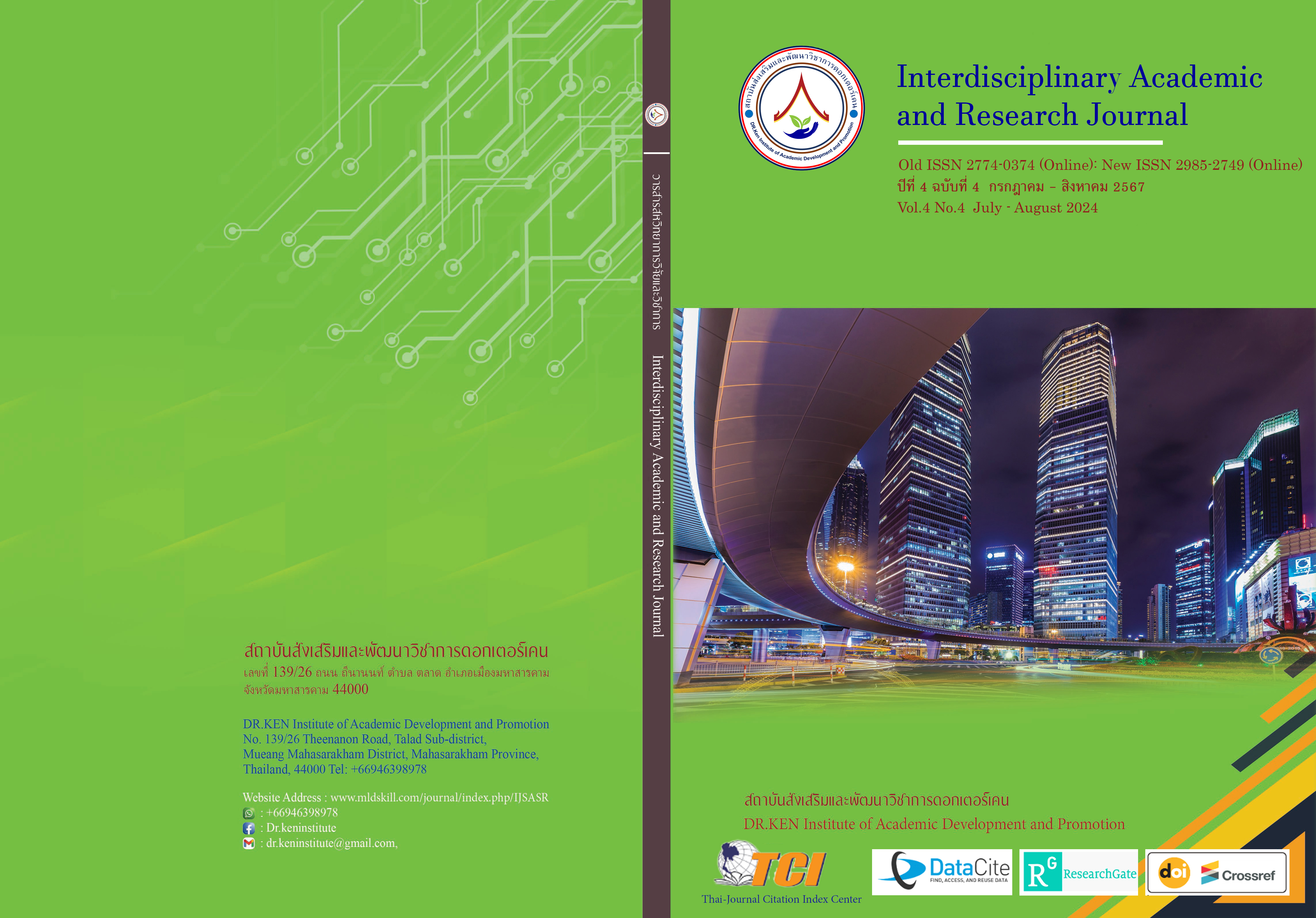The Development of Learning Activity on Electricity to Promote Creative Thinking for Grade 4 Students
DOI:
https://doi.org/10.60027/iarj.2024.273283Keywords:
Project-Based Learning; , Creative ThinkingAbstract
Background and Aims: Develop project-based learning activities on electricity to promote the creativity of 6th-grade students. For students to learn with understanding, stimulate and bring interest, causing students to connect many different types of knowledge together. Makes students learn and have the initiative to improve, create, and design new inventions to be more durable or novel. This research has the objective (1) To develop project-based learning activities about electricity for Grade 6 students. And (2) To compare the creativity of students before and after studying with project-based learning.
Methodology: The study group consisted of 9 students in Prathom 6 at Ban Yang Noi School, Kosum Phisai District, Maha Sarakham Province. Tools used include (1) 1 project-based learning plan, total 14 hours. (2) The creativity test is a subjective test with 4 questions and 4 areas with an accuracy value (IOC) equal to 0.60-1.00, a discriminatory power value between 0.20–0.77, and a confidence value equal to 0.70. Statistics used include percentage, mean, and standard deviation. And test the hypothesis using Wilcoxon Signed-rank Tests.
Results: (1) Development of project-based learning activities on electricity for students in Grade 6. From the evaluation of the quality of learning activities, it was found that they were at the most appropriate level. And (2) Students who received project-based learning had higher creativity after studying than before, with statistical significance at the .05 level.
Conclusion: Students in Grade 6 were found to benefit from project-based learning activities that centered on electricity and met their learning objectives. Furthermore, following project engagement, students demonstrated noticeably increased creativity, highlighting the effectiveness of this strategy in encouraging creative thinking.
References
กระทรวงศึกษาธิการ. (2552). หลักสูตรแกนกลางการศึกษาขั้นพื้นฐานพุทธศักราช 2551. พิมพ์ครั้งที่ 3. กรุงเทพฯ. โรงพิมพ์ชุมนุม สหกรณ์การเกษตรแห่งประเทศไทย จำกัด.
กรุณา เสนาฤทธิ์, อรัญ ซุยกระเดื่อง และ ประจัญ จันเติบ. (2556). การสร้างแบบทดสอบวัดความสามารถการคิดสร้างสรรค์ วิชาภาษาไทยชั้นประถมศึกษาปีที่ 6. วารสารมหาวิทยาลัยราชภัฏมหาสารคาม (มนุษยศาสตร์และสังคมศาสตร์), 7(1), 97-106.
จริยา พิชัยคำ. (2559). ทักษะการเรียนรู้และนวัตกรรมพัฒนาได้ด้วยการจัดการเรียนรู้แบบโครงงานเป็นฐาน. วารสารวิชาการมหาวิทยาลัยราชภัฏอุตรดิตถ์, 11(1), 1-12.
จารุวรรณ เสียงไพเราะ, ศักดิ์ศรี สุภาษร และ กิติยา วงษ์ขัน. (2554). การพัฒนาทักษะกระบวนการวิทยาศาสตร์ และผลสัมฤทธิ์ทางการเรียนโดยใช้ชุดการเรียนรู้แบบโครงงานวิทยาศาสตร์เป็นฐาน เรื่องพอลิเมอร์ธรรมชาติ. การประชุมวิชาการระดับชาติมหาวิทยาลัยบูรพา (หน้า 1–15), มหาวิทยาลัยบูรพา ชลบุรี.
ชาตรี เกิดธรรม. (2547). เทคนิคการสอนแบบโครงงาน. กรุงเทพฯ: ชมรมเด็ก.
ทิศนา แขมมณี. (2556). ศาสตร์การสอน: องค์ความรู้เพื่อการจัดกระบวนการเรียนรู้ที่มีประสิทธิภาพ. พิมพ์ครั้งที่ 17. กรุงเทพฯ: จุฬาลงกรณ์มหาวิทยาลัย.
นิลาวรรณ สิงห์งาม. (2559). การพัฒนาบทเรียนบนเว็บโดยใช้โครงงานเป็นฐานร่วมกับกระบวนการสอนแบบซินเน็คติกส์ ที่ส่งเสริมความคิดสร้างสรรค์ สำหรับนักเรียนชั้นมัธยมศึกษาปีที่ 3. วารสารบัณฑิตศึกษา มหาวิทยาลัยราชภัฏสกลนคร, 13(60), 151-161.
บุญชม ศรีสะอาด. (2556). วิธีการทางสถิติสาหรับการวิจัย เล่ม 1. พิมพ์ครั้งที่ 5. กรุงเทพฯ: สุวีริยาสาส์.
ประกายฉัตร ขวัญแก้ว (2559), ผลของการจัดการเรียนรู้แบบโครงการเป็นฐาน Project-Based Learning (PjBL) ที่มีต่อความคิดสร้างสรรค์สำหรับนักศึกษาระดับประกาศนียบัตรวิชาชีพชั้นสูง สาขาวิชาการเลขานุการ. วารสารเทคโนโลยีภาคใต้, 9(1), 1-6.
ปิ่นทอง วิหารธรรม และพงศ์ธนัช แซ่จู. (2560). ผลการจัดการเรียนรู้แบบโครงงานเป็นฐานร่วมกับห้องเรียนกลับทางเพื่อส่งเสริมความคิดสร้างสรรค์ในการออกแบบสิ่งของเครื่องใช้ด้วยโปรแกรมคอมพิวเตอร์. วารสารศึกษาศาสตร์ มหาวิทยาลัยขอนแก่น, 11(2), 164-175.
สถาบันส่งเสริมการสอนวิทยาศาสตร์และเทคโนโลยี. (2546). การจัดสาระการเรียนรู้วิทยาศาสตร์หลักสูตรการศึกษาขั้นพื้นฐาน. กรุงเทพฯ: สถาบันส่งเสริมการสอนวิทยาศาสตร์และเทคโนโลยี.
สมเกียรติ พรพิสุทธิมาศ. (2551). การสอนวิทยาศาสตร์โดยเน้นทักษะกระบวนการทางวิทยาศาสตร์. ก้าวทันโลกวิทยาศาสตร์, 8(2), 28-38.
สรกฤช มณีวรรณ. (2561). การพัฒนารูปแบบการเรียนรู้แบบโครงงานร่วมกับเทคนิคซินเน็คติกส์ผ่านคลาวด์เทคโนโลยีเพื่อส่งเสริมความคิดสร้างสรรค์และการสร้างนวัตกรรม. วารสารการอาชีวะและเทคนิคศึกษา, 8(15), 63-76.
สํานักงานคณะกรรมการการอาชีวศึกษา กระทรวงศึกษาธิการ. (2562). หลักสูตรประกาศนียบัตรวิชาชีพพุทธศักราช. กรุงเทพฯ: จุฬาลงกรณ์มหาวิทยาลัย.
สุคนธ์ สินธพานนท์. (2545). การจัดกระบวนการเรียนรู้เน้นผู้เรียนเป็นสำคัญตามหลักสูตรการศึกษาขั้นพื้นฐาน. กรุงเทพฯ: อักษรเจริญทัศน์.
สุวิทย์ มูลคำ. (2551). การจัดกิจกรรมการเรียนรู้ที่เน้นการคิด. กรุงเทพฯ: ภาพพิมพ์.
อัญชลี ทองเอม. (2561). การเรียนรู้โดยใช้โครงงานเพื่อพัฒนาผู้เรียนในศตวรรษที่ 21. วารสารวไลยอลงกรณ์ปริทัศน์ (มนุษยศาสตร์และสังคมศาสตร์), 8(3), 185-199.
Buck Institute for Education (BIE) (2013). Gold Standard PBL: Essential Project Design Elements. Retrieved From: http://bie.org/object/document/goldstandard_pbl_essential_project_design_elements.
Guilford, J.P. (1959). Fundamental Statistics in Psychology and Education. New York: McGraw-Hill.
Norris, S., & Phillps, L. (2003). How literacy in its fundamental sense is central to scientific literacy. Science Education, 87 (2), 224–240. https://doi.org/10.1002/sce.10066
Taylor, C.W. (1964). Creativity: Progress and Potential. New York: McGraw-Hill.
Downloads
Published
How to Cite
Issue
Section
License
Copyright (c) 2024 Interdisciplinary Academic and Research Journal

This work is licensed under a Creative Commons Attribution-NonCommercial-NoDerivatives 4.0 International License.
Copyright on any article in the Interdisciplinary Academic and Research Journal is retained by the author(s) under the under the Creative Commons Attribution-NonCommercial-NoDerivatives 4.0 International License. Permission to use text, content, images, etc. of publication. Any user to read, download, copy, distribute, print, search, or link to the full texts of articles, crawl them for indexing, pass them as data to software, or use them for any other lawful purpose. But do not use it for commercial use or with the intent to benefit any business.
















.png)


